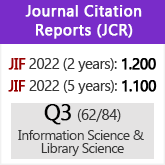Indicators to evaluate the quality of online journalism web sites: an analysis of Web 2.0 interaction and adoption
DOI:
https://doi.org/10.3989/redc.2012.1.858Keywords:
Analysis and evaluation of digital resources, methodology of analysis and evaluation, indicators, media, online media, news websites, Web 2.0, cooperation, interaction, socialization, content quality, participationAbstract
Due to the increasing adaptation made by the mass media to the Web scenario, there is need for a methodology to allow us to analyze and evaluate the quality of news websites. Based on a study of the characteristics of the websites of the major news media, this article proposes a specific methodology for the evaluation of this sort of website. The proposed methodology consists of thirty-six indicators, organized around eight parameters that evaluate, mainly, the degree of adaptation of the media to Web 2.0 interaction. Apart from that, other aspects are evaluated, such as information architecture, accessibility, usability and the interaction and communication tools offered to users.
Downloads
References
Bradshaw, P. (2008). How interactive are UK business news websites? Online Journalism Blog, April 7. [En línea] <http://bit.ly/fXusoY> [consulta: 11/04/2011].
Codina, L. (2000). Evaluación de recursos digitales en línea. Revista Española de Documentación Científica, v. 23, n. 1, 9-44. http://dx.doi.org/10.3989/redc.2000.v23.i1.315
Codina, L. (2006). Evaluación de calidad en sitios web: Metodología de proyectos de análisis sectoriales y de realización de auditorías. Barcelona; Universidad Pompeu Fabra, Área de Biblioteconomía y Documentación, p. 13 [En línea] <http://www.lluiscodina.com/metodos/procedimientos2006.doc> [consulta: 12/04/2011],
Díaz Noci, J. (2005). Periodismo en Internet: Investigar los nuevos medios. En: Xosé López García, Xosé Pereira, Xosé Villanueva (editores) Investigar sobre periodismo: Reunión científica de la Sociedad Española de Periodística (SEP). Santiago de Compostela; Universidade, Servizo de Publicacións e Intercambio Científico, 74-100.
Díaz Noci, J. y otros. (2009). Content and message analysis of online journalism: some methodological proposals. Proceedings of the V International Conference: Comunication and Reality, 647-656, Trípodos [Extra 2009].
Geary, J. (2008) Interaction on business news websites (Infografía). [En línea] <http://bit.ly/eOby5t> [consulta: 11/04/2011].
Glocer, T. (2006). Old media must embrace the amateur. Financial Times, published: March 8. [En línea] <http://on.ft.com/gFBM6s> [consulta: 20/03/2011].
Guallar, J., y Abadal, E. (2009). Evaluación de las hemerotecas de prensa digital: indicadores y ejemplos de buenas prácticas. El profesional de la información, 2009, mayojunio, v. 18, n. 3, 255-269.
Horrigan, J. B. (2006). For many home broadband users, the internet is a primary news source (Technical report). Washington, DC; Pew Internet and American Life Project, p. 27. [En línea] <http://bit.ly/tTfqZN> [consulta: 10/12/2011].
Johnson, B. (2006). Google News under fire. The Guardian, published: March 2. [En línea] <http://bit.ly/hKgUWN> [consulta: 11/04/2011].
López García, G. (ed.) (2008). Comunicación local y nuevos formatos periodísticos en Internet: cibermedios, confidenciales y weblogs. Valencia; Servei de Publicacions de la Universitat de València, p.208. [En línea] <http://bit.ly/gmbXSs> [consulta: 11/04/2011].
Meso, K., y Palomo, B. (2008). Los blogs de autor en los ciberdiarios de referencia españoles. Prisma.com, n. 7. [En línea] <http://bit.ly/h4uLox> [consulta: 11/04/2011].
Palacios, M., y Díaz Noci, J. (eds.) (2009). Online Journalism: Research Methods: A multidisciplinary approach in comparative perspective. Bilbao; Servicio Editorial de la Universidad del País Vasco, p. 178. [En línea] <http://bit.ly/edPQFD> [consulta: 11/04/2011].
Pew Research Center (2011). The State of the News Media 2011: Online (Technical report). [En línea] <http://bit.ly/gmbXSs> [consulta: 11/04/2011].
Rodríguez-Martínez, R., y Pedraza-Jiménez, R. (2009). Prensa digital y Web 2.0. Hipertext. net, n. 7. [En línea] <http://bit.ly/fHPpZo> [consulta: 11/04/2011].
Rodríguez-Martínez, R.; Codina, L., y Pedraza-Jiménez, R. (2010). Cibermedios y web 2.0: modelo de análisis y resultado de aplicación. El profesional de la información, v. 19, n. 1, 35-44.
Salaverría, R. y otros. (2005). Spain: Multimedia Richness and variety of business models. En: Richard van der Wurff, Edmund Lauf, John O’Sullivan (eds.) Print and Online Newspapers in Europe: A Comparative Content Analysis in 16 countries in Western and Eastern Europe. Amsterdam: Het Spinhuis, 231-244.
Schutz, T. (1999). Interactive options in Online Journalism: A Content Analysis of 100 U.S. Newspapers. Journal of Computer Mediated Communication, 5 (1). [En línea] <http://bit.ly/eKqbUO> [consulta: 11/04/2011].
The Bivings Group (2008). The Use of the Internet by America’s Largest Newspapers (2008 Edition) (Technical report). [En línea] <http://bit.ly/gJr4mo> [consulta: 11/04/2011].
Wurff, R.; Lauf, E., y O’Sullivan, J. (eds.) (2005). Print and Online Newspapers in Europe: A Comparative Content Analysis in 16 countries in Western and Eastern Europe. Amsterdam: Het Spinhuis, p. 326.
Zamith, F. (2008). Ciberjornalismo: As potencialidades da Internet nos sites noticiosos portugueses. Porto; Afrontamento, p. 113.
Downloads
Published
How to Cite
Issue
Section
License
Copyright (c) 2012 Consejo Superior de Investigaciones Científicas (CSIC)

This work is licensed under a Creative Commons Attribution 4.0 International License.
© CSIC. Manuscripts published in both the printed and online versions of this Journal are the property of Consejo Superior de Investigaciones Científicas, and quoting this source is a requirement for any partial or full reproduction.All contents of this electronic edition, except where otherwise noted, are distributed under a “Creative Commons Attribution 4.0 International” (CC BY 4.0) License. You may read here the basic information and the legal text of the license. The indication of the CC BY 4.0 License must be expressly stated in this way when necessary.
Self-archiving in repositories, personal webpages or similar, of any version other than the published by the Editor, is not allowed.

















